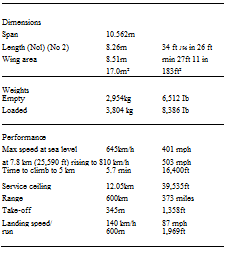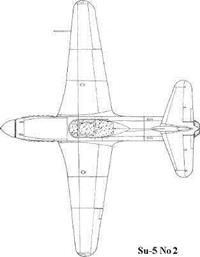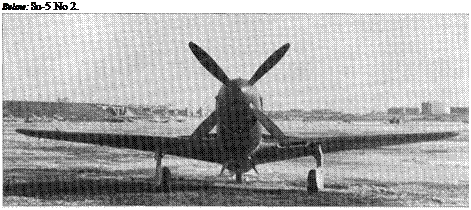Sukhoi Su-5,I-107
Purpose: To create an interceptor with piston engine plus VRDKpropulsion.
Design Bureau: P O Sukhoi, Moscow.
The urgent demand for faster fighters, to meet the competition of German and Allied jets revealed in January 1944, is given in the story of the Mikoyan I-250 (N). Apart from Mikoyan Sukhoi was the only designer to respond to this call, and (because the propulsion system was the same) he created a very similar aircraft. Two examples were funded, the second being used for tunnel testing at CAHI (TsAGI). The red-painted flight article first flew – it is believed, at Novosibirsk – on 6th April 1945, a month after its rival. On 15th July 1945 the test programme was interrupted by failure of the main engine, and the opportunity was taken to fit a new wing with CAHI (TsAGI) laminar profile. In August the replacement engine failed. As no replacement VK-107A was available, and such aircraft were by this time outmoded, the test programme was discontinued.
The Su-5 was a conventional fighter of its time, notable only for its small size and deep fuselage to accommodate the VRDK duct. The second wing fitted had a 16.5-per-cent CAHI 1VI0 profile at the root, thinned down to 11 per cent NACA-230 near the tip. It was made in three parts, with bolted joints outboard of the landing gears. The split flaps spanned this joint. The Frise ailerons were fully balanced, the port surface having a trim tab. Most of the fuselage was occupied by the propulsion system. The VK-107A engine, rated at l,650hp, drove a four-blade 2.89m (9ft 5%in) propeller, with a clutched rear drive to a 13:21 step-up gearbox to the VRDK compressor. In the duct were the carburettor inlets, radiator, seven combustion chambers and double-wall pipe of heat-resistant steel leading to a variable propulsive nozzle. The No 2 aircraft had a circular multi-flap nozzle projecting behind the fuselage. In the left inner wing was a broad but shallow inlet for the ducted oil cooler, with exit under the wing. This required a modified upper door to the left landing gear, with 650 x 200 tyres and track of3.15m (10ft 4in). The tail – wheel, with 300×125 tyre, retracted into an open asbestos-lined box in a ventral fairing. The rudder and inset-hinge elevators all had spring-tab drives. The cockpit had 10mm (%in) back armour and a sliding canopy, the No 2 aircraft having a transparent rear fairing. Three tanks housed 646 litres (142 Imperial gallons) of fuel, consumed in lOmin of VRDK operation. Armament comprised one NS-23 with 100 rounds and two UBS with 400 rounds above the engine.



 Sukhoi said later this aircraft was a ‘nonstarter’ from the outset.
Sukhoi said later this aircraft was a ‘nonstarter’ from the outset.










